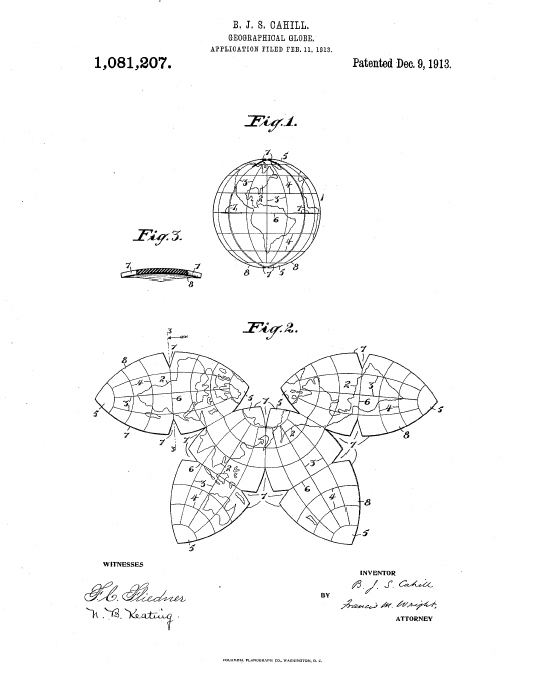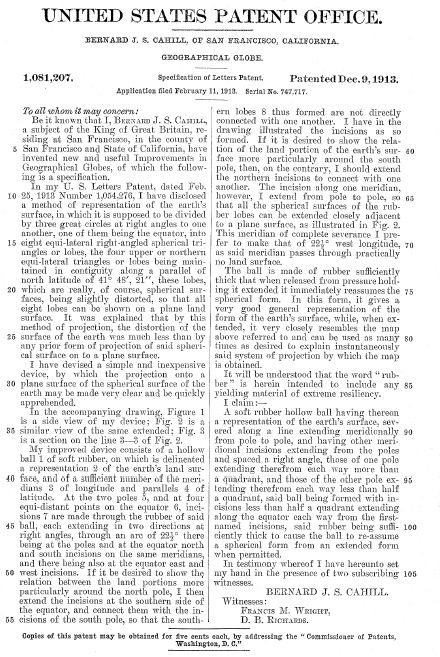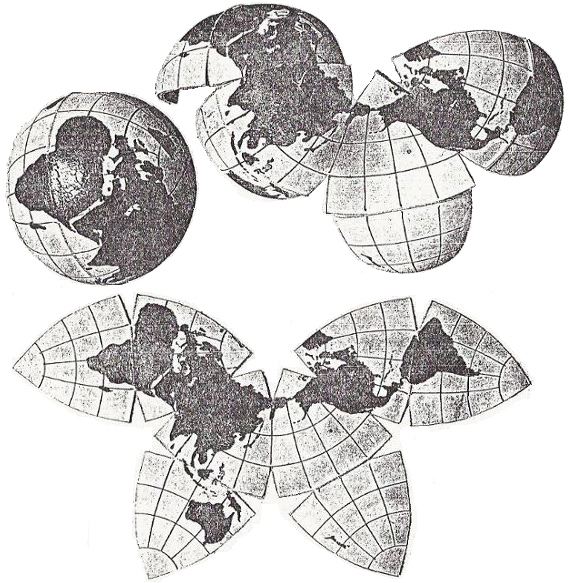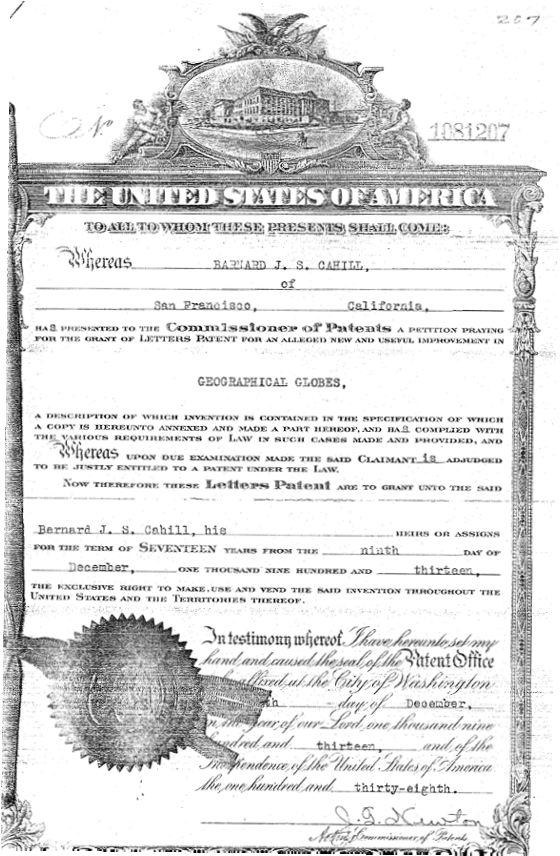Note by GK: This is B.J.S. Cahill's
other 1913 patent, #1,081,207, for his rubber-ball globe which can flatten
to a Butterfly World Map. It is also available via Google Patent Search but I
am reposting it here in three different formats for convenience because not
all browsers can properly display the cluttered online pdf / flash versions.
(1) Directly below are my jpegs of the pdf; or (2) click here for the pdf itself, on my website without flash. And just for clarity, I am including (3), Google's plain text rendition of the pdf, as corrected and re-formatted by me, further below; as well as an actual photo of the globe-map, which is not included with the patent. Plus the "Letters Patent" itself.
It needs a snappier name than "Geographical Globe". Should we call it a "Globe>Map>Globe"? Or a "Globe-O-Map"? Or a "Map-'n'-Globe"? Or?
(1) Directly below are my jpegs of the pdf; or (2) click here for the pdf itself, on my website without flash. And just for clarity, I am including (3), Google's plain text rendition of the pdf, as corrected and re-formatted by me, further below; as well as an actual photo of the globe-map, which is not included with the patent. Plus the "Letters Patent" itself.
It needs a snappier name than "Geographical Globe". Should we call it a "Globe>Map>Globe"? Or a "Globe-O-Map"? Or a "Map-'n'-Globe"? Or?


UNITED STATES PATENT OFFICE.
BERNARD J. S. CAHILL, OF SAN FRANCISCO, CALIFORNIA.
GEOGRAPHICAL GLOBE.
1,081,207. Specification of letters Patent. Patented Dec. 9,1913.
Application filed February 11,1913. Serial No. 747,717.
BERNARD J. S. CAHILL, OF SAN FRANCISCO, CALIFORNIA.
GEOGRAPHICAL GLOBE.
1,081,207. Specification of letters Patent. Patented Dec. 9,1913.
Application filed February 11,1913. Serial No. 747,717.
To all whom it may concern:
Be it known that I, Bernard J. S. Cahill, a subject of the King of Great Britain, residing at San Francisco, in the county of
5
San Francisco and State of California, have invented new and useful Improvements in Geographical Globes, of which the following is a specification.
In my U. S. Letters Patent, dated Feb.
10
25, 1913 Number 1.054.276. I have disclosed a method of representation of the earth's surface, in which it is supposed to be divided by three great circles at right angles to one another, one of them being the equator, into
15
eight equi-lateral right-angled spherical triangles or lobes, the four upper or northern equi-lateral triangles or lobes being maintained in contiguity along a parallel of north latitude of 41° 48', 21", these lobes,
20
which are really, of course, spherical surfaces, being slightly distorted, so that all eight lobes can be shown on a plane land surface. It was explained that by this method of projection, the distortion of the
25
surface of the earth was much less than by any prior form of projection of said spherical surface on to a plane surface.
I have devised a simple and inexpensive device, by which the projection onto a
30
plane surface of the spherical surface of the earth may be made very clear and be quickly apprehended.
In the accompanying drawing, Figure 1 is a side view of my device; Fig. 2 is a
35
similar view of the same extended; Fig. 3 is a section on the line 3—3 of Fig. 2.
My improved device consists of a hollow ball 1 of soft rubber, on which is delineated a representation 2 of the earth's land sur-
40
face, and of a sufficient number of the meridians 3 of longitude and parallels 4 of latitude. At the two poles 5, and at four equi-distant points on the equator 6, incisions 7 are made through the rubber of said
45
ball, each extending in two directions at right angles, through an arc of 22-£° there being at the poles and at the equator north and south incisions on the same meridians, and there being also at the equator east and
50
west incisions. If it be desired to show the, relation between the land portions more particularly around the north pole, I then extend the incisions at the southern side of the equator, and connect them with the in-
55
cisions of the south pole, so that the southern lobes 8 thus formed are not directly connected with one another. I have in the drawing illustrated the incisions as so formed. If it is desired to show the relation of the land portion of the earth's sur-
60
face more particularly around the south pole, then, on the contrary, I should extend the northern incisions to connect with one another. The incision along one meridian, however, I extend from pole to pole, so
65
that all the spherical surfaces of the rubber lobes can be extended closely adjacent to a plane surface, as illustrated in Fig. 2. This meridian of complete severance I prefer to make that of 22 1/2° west longitude,
70
as said meridian passes through practically no land surface.
The ball is made of rubber sufficiently thick that when released from pressure holding it extended it immediately reassumes the
75
spherical form. In this form, it gives a very good general representation of the form of the earth's surface, while, when extended, it very closely resembles the map above referred to and can be used as many
80
times as desired to explain instantaneously said system of projection by which the map is obtained.
It will be understood that the word "rubber" is herein intended to include any
85
yielding material of extreme resiliency.
I claim:—
A soft rubber hollow ball having thereon a representation of the earth's surface, severed along a line extending meridionally
90
from pole to pole, and having other meridional incisions extending from the poles and spaced a right angle, those of one pole extending therefrom each way more than a quadrant, and those of the other pole ex-
95
tending therefrom each way less than half a quadrant, said ball being formed with incisions less than half a quadrant extending along the equator each way from the first- named incisions, said rubber being suffi-
100
ciently thick to cause the ball to re-assume a spherical form from an extended form when permitted.
In testimony whereof I have hereunto set my hand in the presence of two subscribing
105
witnesses.
Be it known that I, Bernard J. S. Cahill, a subject of the King of Great Britain, residing at San Francisco, in the county of
5
San Francisco and State of California, have invented new and useful Improvements in Geographical Globes, of which the following is a specification.
In my U. S. Letters Patent, dated Feb.
10
25, 1913 Number 1.054.276. I have disclosed a method of representation of the earth's surface, in which it is supposed to be divided by three great circles at right angles to one another, one of them being the equator, into
15
eight equi-lateral right-angled spherical triangles or lobes, the four upper or northern equi-lateral triangles or lobes being maintained in contiguity along a parallel of north latitude of 41° 48', 21", these lobes,
20
which are really, of course, spherical surfaces, being slightly distorted, so that all eight lobes can be shown on a plane land surface. It was explained that by this method of projection, the distortion of the
25
surface of the earth was much less than by any prior form of projection of said spherical surface on to a plane surface.
I have devised a simple and inexpensive device, by which the projection onto a
30
plane surface of the spherical surface of the earth may be made very clear and be quickly apprehended.
In the accompanying drawing, Figure 1 is a side view of my device; Fig. 2 is a
35
similar view of the same extended; Fig. 3 is a section on the line 3—3 of Fig. 2.
My improved device consists of a hollow ball 1 of soft rubber, on which is delineated a representation 2 of the earth's land sur-
40
face, and of a sufficient number of the meridians 3 of longitude and parallels 4 of latitude. At the two poles 5, and at four equi-distant points on the equator 6, incisions 7 are made through the rubber of said
45
ball, each extending in two directions at right angles, through an arc of 22-£° there being at the poles and at the equator north and south incisions on the same meridians, and there being also at the equator east and
50
west incisions. If it be desired to show the, relation between the land portions more particularly around the north pole, I then extend the incisions at the southern side of the equator, and connect them with the in-
55
cisions of the south pole, so that the southern lobes 8 thus formed are not directly connected with one another. I have in the drawing illustrated the incisions as so formed. If it is desired to show the relation of the land portion of the earth's sur-
60
face more particularly around the south pole, then, on the contrary, I should extend the northern incisions to connect with one another. The incision along one meridian, however, I extend from pole to pole, so
65
that all the spherical surfaces of the rubber lobes can be extended closely adjacent to a plane surface, as illustrated in Fig. 2. This meridian of complete severance I prefer to make that of 22 1/2° west longitude,
70
as said meridian passes through practically no land surface.
The ball is made of rubber sufficiently thick that when released from pressure holding it extended it immediately reassumes the
75
spherical form. In this form, it gives a very good general representation of the form of the earth's surface, while, when extended, it very closely resembles the map above referred to and can be used as many
80
times as desired to explain instantaneously said system of projection by which the map is obtained.
It will be understood that the word "rubber" is herein intended to include any
85
yielding material of extreme resiliency.
I claim:—
A soft rubber hollow ball having thereon a representation of the earth's surface, severed along a line extending meridionally
90
from pole to pole, and having other meridional incisions extending from the poles and spaced a right angle, those of one pole extending therefrom each way more than a quadrant, and those of the other pole ex-
95
tending therefrom each way less than half a quadrant, said ball being formed with incisions less than half a quadrant extending along the equator each way from the first- named incisions, said rubber being suffi-
100
ciently thick to cause the ball to re-assume a spherical form from an extended form when permitted.
In testimony whereof I have hereunto set my hand in the presence of two subscribing
105
witnesses.
BERNARD J. S. CAHILL.
Witnesses :
F. M. Wright
D. B. Richards
Copies of this patent may be obtained for
five cents each,
by addressing the "Commissioner of Patents, Washington, D. C."
by addressing the "Commissioner of Patents, Washington, D. C."
[GK note: Not included in the
patent, this is a photo of the rubber-ball globe-map; see source
notes in my first Cahill Gallery.]

[And by the way, below is what a "Patent" itself
looks like. The foregoing was just a specification of the object. Here is
a Xerox (from Bancroft
Library) of the actual "Letters Patent" granted to Cahill — for
what it was worth I don't know if that ball was ever manufactured, beyond
the simple prototype, now at Bancroft. I still think it would make a superb,
and very inexpensive, educational object. And object lesson showing how Cahill's
projection was truly the alter ego of a globe.]
